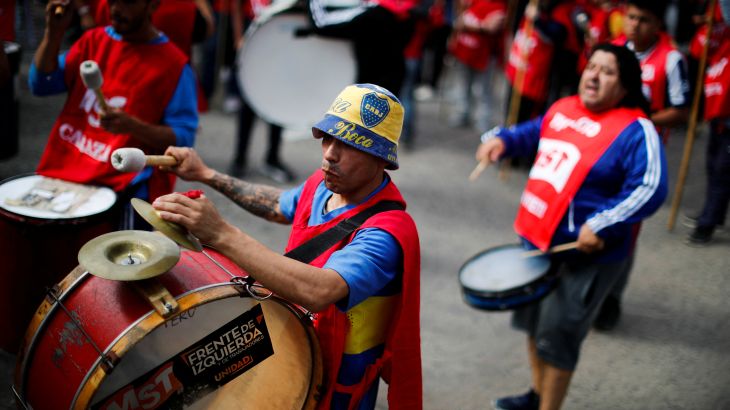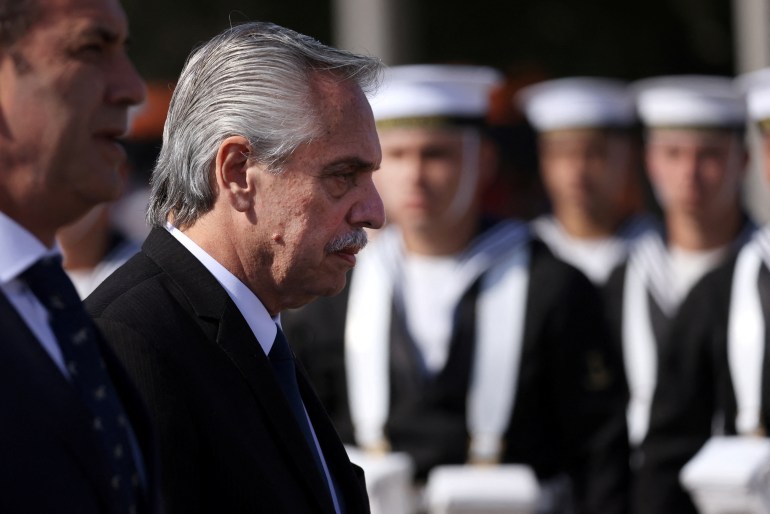Could BRICS rescue Argentina’s economy?
Right-wing presidential candidates tout commitment to the West, but severe financial crisis could necessitate a shift.

Buenos Aires, Argentina – Patricia Bullrich is working the crowd. Speaking to representatives of more than 600 companies at the 2023 AmCham Summit in Buenos Aires, the former left-wing rebel fighter and current right-wing presidential hopeful acknowledges that she would be merely an electoral “option” during more stable times.
But these are not stable times in Argentina — not with the inflation rate topping 100 percent and poverty hovering close to 40 percent.
Keep reading
list of 3 itemsArgentina to renew push for sovereignty over Falkland Islands
Argentina’s grain harvest suffers under worst drought in 60 years
In Bullrich’s telling, her “character and determination” could be the salvation for a country grappling with a $44.5bn debt to the International Monetary Fund (IMF) and a once-in-a-century drought that has halved its output of soy and wheat. Under these circumstances, would a Bullrich administration embrace membership in BRICS — an alliance that’s an acronym for US adversaries Russia and China, along with Brazil, India and South Africa?
“We’re not going to BRICS,” she says during a Q&A at the summit, adding that her geopolitical allies would be the “democracies” of the United States, Western Europe and Israel.
Buenos Aires Mayor Horacio Rodriguez Larreta, another leading candidate for president from the same centre-right Juntos por el Cambio (Together for Change) coalition, made similar comments to the AmCham crowd this month but said he would be willing to trade with any nation, including those in BRICS.
Still, whoever prevails in this October’s presidential election may not have the luxury of pursuing their political convictions in an increasingly multipolar world.
Argentina is facing its worst economic crisis since the depression of 1998 to 2002, when unemployment climbed above 20 percent and more than half of the population slid below the poverty line. President Alberto Fernandez of the centre-left Frente de Todos (Everyone’s Front) coalition has already announced that he will not seek a second term, while his vice president, Cristina Fernandez de Kirchner, has declined to run following a controversial fraud conviction.

Last June, in a video conference with BRICS representatives and heads of state, Fernandez requested full membership in the group on behalf of Argentina. More recently, Brazilian President Luiz Inacio Lula da Silva pledged to help “remove [the IMF’s] knife from Argentina’s neck”.
Whether the South American nation will ultimately join BRICS remains an open question, although it is unlikely before the October election. There is also no guarantee that membership would move the needle. What is clear, however, is that Argentina could use all the help it can get.
“When you’re in the opposition, you’re free to say whatever you want,” Vicky Murillo, director of the Institute of Latin American Studies at Columbia University in New York City, told Al Jazeera. “But if either coalition wins, the next government will have to pay close attention to Brazil and China. Those relationships are too important to make ideological distinctions.”
Emerging markets
Coined by a Goldman Sachs analyst in 2001, BRICS (then BRIC) is an acronym used to describe some of the largest emerging markets in the world. The countries held their first diplomatic summit in Yekaterinburg, Russia, in 2009, and the nascent bloc added South Africa the following year.
Representing more than 40 percent of the world’s population, BRICS was conceived as a counterweight to the G7 countries that have long dominated the global economy and its financial institutions. To that end, the bloc established the New Development Bank during its sixth annual summit in Fortaleza, Brazil, in 2014.
“The founding logic of the New Development Bank is to have an alternative financing mechanism that emphasises the needs of developing countries rather than those of wealthy nations,” said Andres Arauz, a senior research fellow at the Center for Economic and Policy Research in Washington, DC, and a former Ecuadorian minister of knowledge.
“Although its goals are ambitious, the NDB only has around $12bn that it can distribute to member countries,” he told Al Jazeera. “But the BRICS nations themselves have trillions of dollars in reserves and a lot of liquidity available to help Argentina refinance its debts.”
To understand why Argentina has pursued a closer relationship with BRICS, one need look no further than its most recent loan from the IMF. In 2018, the fund provided a record $57bn to the right-wing administration of then-President Mauricio Macri.
But rather than rebuilding Argentina’s crumbling infrastructure, that money was largely used to finance capital flight — a violation of the IMF’s bylaws. The economy stalled, inflation soared to more than 50 percent in 2019, and voters ended Macri’s presidency after a single term. His successor, Alberto Fernandez, cancelled the final tranche of the loan, but his administration has failed to staunch the bleeding.
The COVID-19 pandemic, a costly war in Ukraine and this year’s historic drought have all served to boost the election prospects of the Juntos por el Cambio candidates, as well as those of La Libertad Avanza’s (Freedom Advances) Javier Milei — a political outsider who has proposed dollarising the Argentinian economy.
“BRICS has the capacity to redefine Argentina’s relationship with debt,” Julio Gambina, an economist and professor at the National University of Rosario in Argentina, told Al Jazeera. “Its investments could allow the country to build a community economy that prioritises the needs of people and families rather than transnational companies. But this is still a theoretical.”
Hampering Argentina’s potential entry to BRICS is its history of joining and later departing international alliances, said Juan Gabriel Tokatlian, a professor of international relations at Torcuato Di Tella University in Buenos Aires.
In 1973, Argentina joined the Non-Aligned Movement — a coalition of countries that stood opposed to Cold War-era polarisation and promoted the interests of the developing world — only to exit the group in 1991. And it was a member of the Union of South American Nations before withdrawing in 2019.
“If Argentina were to gain entrance to BRICS only to drop out because an entering government has a different political orientation, that would be very costly,” Tokatlian told Al Jazeera. “At the same time, the BRICS countries want to be certain that new entrants to the bloc will remain. So they’re making their own strategic calculations.”